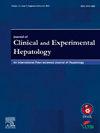Serum Bile Acid Elevation is an Independently Associated With Pruritus in Patients With At-risk Metabolic Dysfunction-associated Steatotic Liver Disease
IF 3.2
Q2 GASTROENTEROLOGY & HEPATOLOGY
Journal of Clinical and Experimental Hepatology
Pub Date : 2025-03-20
DOI:10.1016/j.jceh.2025.102549
引用次数: 0
Abstract
Background and aims
Elevated serum bile acids are associated with pruritus in cholestatic liver diseases. We assessed the association of serum bile acids and other putative biomarkers of cholestatic pruritus (autotaxin and interleukin-31 (IL-31) with pruritus in patients with metabolic dysfunction-associated steatotic liver disease (MASLD).
Methods
We used serum from patients with MASLD and metabolic dysfunction-associated steatohepatitis (MASH), viral hepatitis B, viral hepatitis C, and healthy blood donors to measure the levels of bile acids, autotaxin, and IL-31. Clinically significant pruritus was defined from the Chronic Liver Disease Questionnaire.
Results
Six hundred fifty-one subjects were included [MASLD (N = 497, 88 MASH), viral hepatitis B and C (VH, N = 98), healthy controls (N = 56)]. Post hoc definitions of high biomarker levels associated with the presence of clinically significant pruritus were as follows: high bile acids ≥5.9 μmol/L, high autotaxin ≥220 ng/mL, and high IL-31 ≥ 25 pg/mL. The VH patients had the highest bile acids levels and lowest levels were in healthy controls (P < 0.0001). The highest autotaxin levels were seen in hepatitis C, while the highest IL-31 levels in MASH. MASH patients had higher levels of all three biomarkers than non-MASH-MASLD. Also, at-risk MASLD or MASLD with advanced fibrosis (AF) had higher bile acids and autotaxin (all P < 0.01) but not IL-31 (P > 0.05). MASLD patients with high bile acids had more pruritus (all MASLD: 25% vs. 17%; MASH 30% vs. 13%; at-risk MASLD: 33% vs. 12%; AF: 41% vs. 8%). In multivariable logistic regressions, having high bile acids was an independent predictor of pruritus in at-risk MASLD [odds ratio (OR) (95% CI) = 4.4 (1.6–12.1)] and MASLD with advanced fibrosis [OR = 7.5 (2.0–29.0)]; but not autotaxin or IL-31 (all P > 0.05).
Conclusions
High serum bile acid level is independently associated with pruritus in at-risk MASLD.

血清胆汁酸升高是高危代谢功能障碍相关脂肪变性肝病患者瘙痒的独立相关因素
背景与目的胆汁淤积性肝病患者血清胆汁酸升高与瘙痒有关。我们评估了代谢功能障碍相关脂肪变性肝病(MASLD)患者的血清胆汁酸和其他可能的胆汁淤积性瘙痒的生物标志物(自身taxin和白细胞介素-31 (IL-31))与瘙痒的关系。方法采用MASLD、代谢功能障碍相关脂肪性肝炎(MASH)、病毒性乙型肝炎、病毒性丙型肝炎和健康献血者的血清,检测胆汁酸、自taxin和IL-31的水平。根据慢性肝病调查问卷确定有临床意义的瘙痒。结果纳入651名受试者[MASLD (N = 497, MASH 88),病毒性乙型肝炎(N = 98),丙型肝炎(N = 98),健康对照(N = 56)]。与临床显著性瘙痒相关的高生物标志物水平的事后定义如下:高胆汁酸≥5.9 μmol/L,高autotaxin≥220 ng/mL,高IL-31≥25 pg/mL。VH患者胆汁酸水平最高,健康对照组最低(P <;0.0001)。自体的士素水平在丙型肝炎中最高,而IL-31水平在MASH中最高。与非MASH- masld患者相比,MASH患者的所有三种生物标志物水平均较高。此外,高危MASLD或晚期纤维化(AF)的MASLD有较高的胆汁酸和自的士素(P <;0.01), IL-31无差异(P >;0.05)。胆汁酸高的MASLD患者有更多的瘙痒(所有MASLD: 25% vs. 17%;MASH 30% vs 13%;高危MASLD: 33% vs. 12%;AF: 41%对8%)。在多变量logistic回归中,高胆汁酸是高危MASLD患者瘙痒的独立预测因子[比值比(OR) (95% CI) = 4.4(1.6-12.1)]和晚期纤维化MASLD患者瘙痒的独立预测因子[OR = 7.5 (2.0-29.0)];但不包括autotaxin或IL-31(所有P >;0.05)。结论高胆汁酸水平与MASLD患者瘙痒独立相关。
本文章由计算机程序翻译,如有差异,请以英文原文为准。
求助全文
约1分钟内获得全文
求助全文
来源期刊

Journal of Clinical and Experimental Hepatology
GASTROENTEROLOGY & HEPATOLOGY-
CiteScore
4.90
自引率
16.70%
发文量
537
审稿时长
64 days
 求助内容:
求助内容: 应助结果提醒方式:
应助结果提醒方式:


